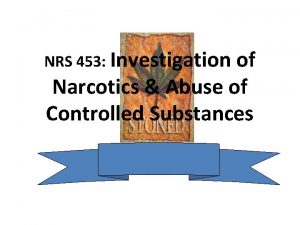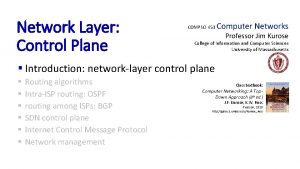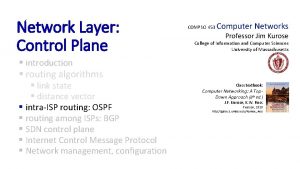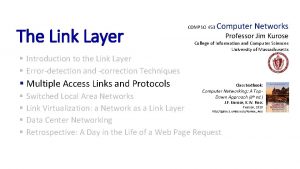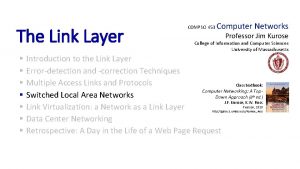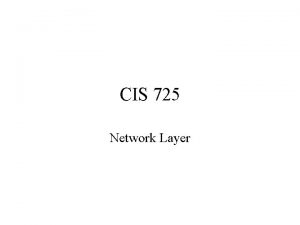Application Layer COMPSCI 453 Principles of network applications


















- Slides: 18

Application Layer § § § § COMPSCI 453 Principles of network applications Web and HTTP E-mail, SMTP, IMAP The Domain Name System: DNS P 2 P applications video streaming, CDNs socket programming with UDP and TCP Computer Networks Professor Jim Kurose College of Information and Computer Sciences University of Massachusetts Class textbook: Computer Networking: A Top. Down Approach (8 th ed. ) J. F. Kurose, K. W. Ross Pearson, 2020 http: //gaia. cs. umass. edu/kurose_ross

DNS: Domain Name System people: many identifiers: • SSN, name, passport # Internet hosts, routers: • IP address (32 bit) - used for addressing datagrams • “name”, e. g. , cs. umass. edu used by humans Q: how to map between IP address and name, and vice versa ? Domain Name System (DNS): § distributed database implemented in hierarchy of many name servers § application-layer protocol: hosts, DNS servers communicate to resolve names (address/name translation) • note: core Internet function, implemented as application-layer protocol • complexity at network’s “edge”

DNS: services, structure DNS services: § hostname-to-IP-address translation § host aliasing • canonical, alias names § mail server aliasing § load distribution • replicated Web servers: many IP addresses correspond to one name Q: Why not centralize DNS? § single point of failure § traffic volume § distant centralized database § maintenance A: doesn‘t scale! § Comcast DNS servers alone: 600 B DNS queries/day § Akamai DNS servers alone: 2. 2 T DNS queries/day

Thinking about the DNS humongous distributed database: § ~ billion records, each simple handles many trillions of queries/day: § many more reads than writes § performance matters: almost every Internet transaction interacts with DNS - msecs count! organizationally, physically decentralized: § millions of different organizations responsible for their records “bulletproof”: reliability, security

DNS: a distributed, hierarchical database Root DNS Servers … …. com DNS servers … … … yahoo. com DNS servers . org DNS servers amazon. com DNS servers pbs. org DNS servers . edu DNS servers Top Level Domain … nyu. edu DNS servers umass. edu DNS servers Authoritative Client wants IP address for www. amazon. com; 1 st approximation: § client queries root server to find. com DNS server § client queries. com DNS server to get amazon. com DNS server § client queries amazon. com DNS server to get IP address for www. amazon. com

DNS: root name servers § official, contact-of-last-resort by name servers that can not resolve name

DNS: root name servers § official, contact-of-last-resort by name servers that can not resolve name § incredibly important Internet function • Internet couldn’t function without it! • DNSSEC – provides security (authentication, message integrity) § ICANN (Internet Corporation for Assigned Names and Numbers) manages root DNS domain 13 logical root name “servers” worldwide each “server” replicated many times (~200 servers in US)

Top-Level Domain, and authoritative servers Top-Level Domain (TLD) servers: § responsible for. com, . org, . net, . edu, . aero, . jobs, . museums, and all top-level country domains, e. g. : . cn, . uk, . fr, . ca, . jp § Network Solutions: authoritative registry for. com, . net TLD § Educause: . edu TLD authoritative DNS servers: § organization’s own DNS server(s), providing authoritative hostname to IP mappings for organization’s named hosts § can be maintained by organization or service provider

Local DNS name servers § when host makes DNS query, it is sent to its local DNS server • Local DNS server returns reply, answering: • from its local cache of recent name-to-address translation pairs (possibly out of date!) • forwarding request into DNS hierarchy for resolution • each ISP has local DNS name server; to find yours: • Mac. OS: % scutil --dns • Windows: >ipconfig /all § local DNS server doesn’t strictly belong to hierarchy

DNS name resolution: iterated query root DNS server Example: host at engineering. nyu. edu wants IP address for gaia. cs. umass. edu Iterated query: § contacted server replies with name of server to contact § “I don’t know this name, but ask this server” 2 3 TLD DNS server 1 4 8 5 requesting host at local DNS server engineering. nyu. edu dns. nyu. edu 7 6 gaia. cs. umass. edu authoritative DNS server dns. cs. umass. edu

DNS name resolution: recursive query root DNS server Example: host at engineering. nyu. edu wants IP address for gaia. cs. umass. edu 7 Recursive query: § puts burden of name resolution on contacted name server § heavy load at upper levels of hierarchy? 3 2 1 6 TLD DNS server 8 requesting host at local DNS server engineering. nyu. edu dns. nyu. edu 5 4 gaia. cs. umass. edu authoritative DNS server dns. cs. umass. edu

Caching DNS Information § once (any) name server learns mapping, it caches mapping, and immediately returns a cached mapping in response to a query • caching improves response time • cache entries timeout (disappear) after some time (TTL) • TLD servers typically cached in local name servers § cached entries may be out-of-date • if named host changes IP address, may not be known Internetwide until all TTLs expire! • best-effort name-to-address translation!

DNS records DNS: distributed database storing resource records (RR) RR format: (name, value, type, ttl) type=A § name is hostname § value is IP address type=NS § name is domain (e. g. , foo. com) § value is hostname of authoritative name server for this domain type=CNAME § name is alias name for some “canonical” (the real) name § www. ibm. com is really servereast. backup 2. ibm. com § value is canonical name type=MX § value is name of SMTP mail server associated with name

DNS protocol messages DNS query and reply messages, both have same format: message header: § identification: 16 bit # for query, reply to query uses same # § flags: • query or reply • recursion desired • recursion available • reply is authoritative 2 bytes identification flags # questions # answer RRs # authority RRs # additional RRs questions (variable # of questions) answers (variable # of RRs) authority (variable # of RRs) additional info (variable # of RRs)

DNS protocol messages DNS query and reply messages, both have same format: name, type fields for a query 2 bytes identification flags # questions # answer RRs # authority RRs # additional RRs questions (variable # of questions) RRs in response to query answers (variable # of RRs) records for authoritative servers authority (variable # of RRs) additional “ helpful” info that may be used additional info (variable # of RRs)

Getting your info into the DNS example: new startup “Network Utopia” § register name networkuptopia. com at DNS registrar (e. g. , Network Solutions) • provide names, IP addresses of authoritative name server (primary and secondary) • registrar inserts NS, A RRs into. com TLD server: (networkutopia. com, dns 1. networkutopia. com, NS) (dns 1. networkutopia. com, 212. 1, A) § create authoritative server locally with IP address 212. 1 • type A record for www. networkuptopia. com • type MX record for networkutopia. com

DNS security DDo. S attacks § bombard root servers with traffic • not successful to date • traffic filtering • local DNS servers cache IPs of TLD servers, allowing root server bypass § bombard TLD servers • potentially more dangerous Spoofing attacks § intercept DNS queries, returning bogus replies § DNS cache poisoning § RFC 4033: DNSSEC authentication services

Application Layer § § § § COMPSCI 453 Principles of network applications Web and HTTP E-mail, SMTP, IMAP The Domain Name System: DNS P 2 P applications video streaming, CDNs socket programming with UDP and TCP Computer Networks Professor Jim Kurose College of Information and Computer Sciences University of Massachusetts Class textbook: Computer Networking: A Top. Down Approach (8 th ed. ) J. F. Kurose, K. W. Ross Pearson, 2020 http: //gaia. cs. umass. edu/kurose_ross Video: 2020, J. F. Kurose, All Rights Reserved Powerpoint: 1996 -2020, J. F. Kurose, K. W. Ross, All Rights Reserved
 Jim kurose
Jim kurose Principles of network applications
Principles of network applications Principles of network applications
Principles of network applications Fig 19
Fig 19 Pathway of food from mouth to anus
Pathway of food from mouth to anus Secure socket layer and transport layer security
Secure socket layer and transport layer security Layer 6 presentation layer
Layer 6 presentation layer Secure socket layer and transport layer security
Secure socket layer and transport layer security Secure socket layer and transport layer security
Secure socket layer and transport layer security Secure socket layer and transport layer security
Secure socket layer and transport layer security Layer 2 e layer 3
Layer 2 e layer 3 Layer-by-layer assembly
Layer-by-layer assembly Layer 2 vs layer 3 bitstream
Layer 2 vs layer 3 bitstream 240 sayısının yüzde 25'i nin yüzde 20'si kaçtır
240 sayısının yüzde 25'i nin yüzde 20'si kaçtır Nrs 453
Nrs 453 Yesus kawan yang sejati kj 453
Yesus kawan yang sejati kj 453 Ece 453
Ece 453 232 en yakın onluğa yuvarlama
232 en yakın onluğa yuvarlama Ce453
Ce453














